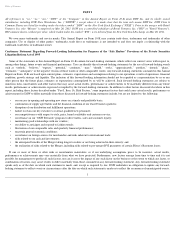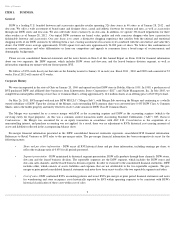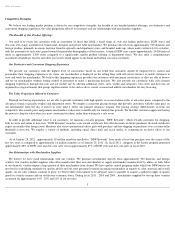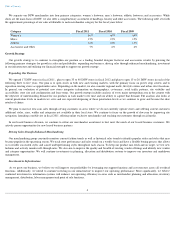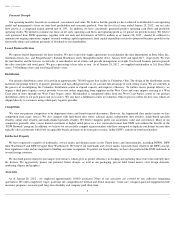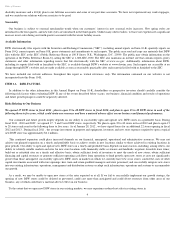DSW 2011 Annual Report Download - page 16
Download and view the complete annual report
Please find page 16 of the 2011 DSW annual report below. You can navigate through the pages in the report by either clicking on the pages listed below, or by using the keyword search tool below to find specific information within the annual report.
Table of Contents
exchange or automated quotation system, it may be difficult to obtain pricing information with respect to the shares. Accordingly, there may be a
limited number of buyers if a holder decided to sell their DSW Class B Common Shares. This may affect the price a holder would receive upon such
sale. Alternatively, a holder of DSW Class B Common Shares could convert them into DSW Class A Common Shares prior to selling. However, this
could affect the timing of any such sale, which may in turn affect the price a holder may receive upon such sale.
If our existing shareholders or holders of warrants to purchase our Common Shares
sell their Common Shares, it could adversely affect the price
of our Class A Common Shares.
The market price of our Class A Common Shares could decline as a result of market sales by our existing shareholders or option holders. These
sales also might make it difficult for us to sell equity securities in the future at a time and at a price that we deem appropriate. We cannot predict the
timing or the size of future sales of our Common Shares by existing shareholders or option holders.
As of January 28, 2012 , there were 31.9 million Class A Common Shares of DSW outstanding. Additionally, there were 0.2 million
director stock
units outstanding as of January 28, 2012 that were issued pursuant to the terms of DSW’s equity incentive plan. The remaining 11.2 million
Class B
Common Shares outstanding are restricted securities within the meaning of Rule 144 under the Securities Act but will be eligible for resale subject to
applicable volume, manner of sale, holding period and other limitations of Rule 144. Our Class B Common Shares can be exchanged for Class A
Common Shares at the election of the holder.
The Schottenstein Affiliates, privately held entities controlled by Jay L. Schottenstein, the executive chairman of the board of directors of DSW,
and members of his family, have the right to acquire Class A or Class B Common Shares of DSW pursuant to warrant agreements. All of these
Common Shares are eligible for future sale, subject to the applicable volume, manner of sale, holding period and other limitations of Rule 144. In
addition, the Schottenstein Affiliates have the right to require that we register for resale in specified circumstances the Class A Common Shares issued
to them upon exercise of their warrants.
Risks Relating to our Relationship with the Schottenstein Affiliates
The Schottenstein Affiliates directly control or substantially influence the outcome of matters submitted for DSW shareholder votes, and their
interests may differ from DSW’s other shareholders.
As of January 28, 2012 , the Schottenstein Affiliates have approximately 75%
of the voting power of the outstanding DSW Common Shares. The
Schottenstein Affiliates directly control or substantially influence the outcome of all matters submitted to DSW’
s shareholders for approval, including
the election of directors, approval of mergers or other business combinations, and acquisitions or dispositions of assets. The interests of the
Schottenstein Affiliates may differ from or be opposed to the interests of DSW’
s other shareholders, and their level of ownership and voting power in
DSW may have the effect of delaying or preventing a subsequent change in control that may be favored by other DSW shareholders.
The Schottenstein Affiliates may compete directly against us.
The Schottenstein Affiliates engage in a variety of businesses, including, but not limited to, business and inventory liquidations, apparel companies
and real estate investments. Opportunities may arise in the area of potential competitive business activities that may be attractive to the Schottenstein
Affiliates and us. Our amended and restated articles of incorporation provide the Schottenstein Affiliates are under no obligation to communicate or
offer any corporate opportunity to us. In addition, the Schottenstein Affiliates have the right to engage in similar activities as us, do business with our
suppliers and customers and, except as limited by the Master Separation Agreement with RVI
, employ or otherwise engage any of our officers or
employees. The provisions of the Master Separation Agreement with RVI
also outline how opportunities are to be assigned in the event that our or the
Schottenstein Affiliates' directors and officers learn of opportunities.
Risks Relating to our Merger with Retail Ventures, Inc.
An annual limitation on DSW
’
s ability to use net operating loss income tax carryforwards may be imposed if there is a change in ownership of
DSW.
After the Merger, the combined entity has significant net operating loss income tax carryforwards, referred to as NOLs, and other income tax
attributes available to reduce taxable income in future years. DSW’
s ability to utilize these NOLs may be limited by section 382 of the Internal
Revenue Code if DSW undergoes an ownership change. An ownership change generally occurs if 5% shareholders (and certain persons treated as 5%
shareholders) of an issuer’s stock, collectively, increase their ownership percentage by more than 50 percentage points within any three-
year period. If
an ownership change occurs, section 382 imposes
11


